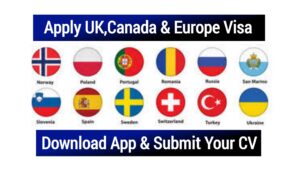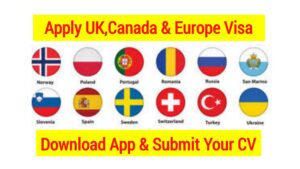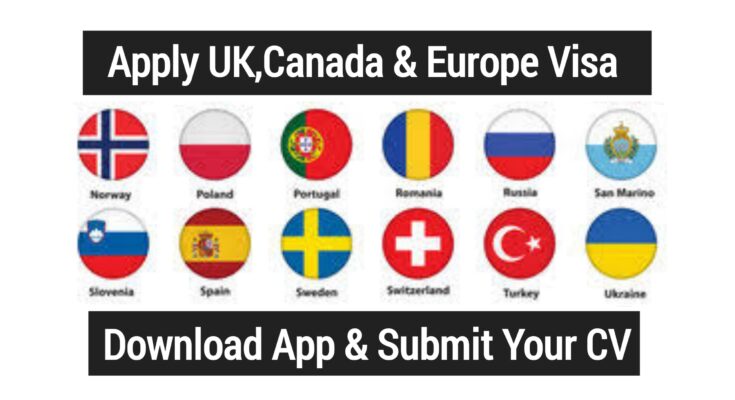1. Introduction: Understanding Visa Applications in 2024
In an increasingly interconnected world, the desire to explore new horizons, whether for work, study, or leisure, has never been more prevalent. As we step into 2024, the landscape of visa applications has evolved, reflecting shifts in global migration patterns, policy changes, and an ever-growing demand for skilled professionals across various industries. Whether you’re dreaming of the stunning landscapes of Canada, the vibrant cities of Australia, or the rich cultural tapestry of Europe, understanding the visa application process is the first step toward making those dreams a reality.
This guide will demystify the often complex and daunting world of visa applications, providing you with essential insights and practical tips tailored for 2024. With each region presenting its unique requirements, eligibility criteria, and application procedures, it’s crucial to navigate this process with clarity and purpose. From gathering necessary documentation to understanding timelines and potential challenges, we’ll equip you with the knowledge to approach your application with confidence.
As you embark on this journey, remember that each visa application is not just a bureaucratic hurdle; it represents an opportunity for growth, adventure, and new experiences. So, whether you’re a student eager to broaden your horizons, a skilled worker seeking new opportunities, or a traveler ready to explore the world, let’s dive into the intricacies of applying for a visa in Canada, Australia, and Europe in 2024. Your journey begins here, and with the right information at your fingertips, you’ll be well on your way to making your international aspirations a reality.
2. Overview of Visa Types for Canada, Australia, and Europe
When considering a move abroad, understanding the myriad of visa options available is crucial. Each destination—Canada, Australia, and countries in Europe—offers a diverse array of visa types tailored to different circumstances and aspirations. Here’s a comprehensive overview to help you navigate your choices effectively.
### Canada
Canada is renowned for its welcoming immigration policies and various pathways for newcomers. The most common visa types include:
– **Express Entry:** A fast-track immigration system for skilled workers, allowing applicants to gain permanent residency based on their qualifications, work experience, and language proficiency.
– **Provincial Nominee Program (PNP):** Each province has its own criteria to attract skilled workers, allowing provinces to nominate applicants for permanent residency based on local labor market needs.
– **Family Sponsorship:** If you have a close relative who is a Canadian citizen or permanent resident, they can sponsor you for a visa, facilitating family reunification.
– **Visitor Visa:** Perfect for those wanting to explore Canada temporarily, this visa permits short visits for tourism or family gatherings.
### Australia
Australia’s immigration system is structured around attracting skilled workers to fill vacancies in various sectors. Key visa categories include:
– **Skilled Independent Visa (subclass 189):** For skilled workers who are not sponsored by an employer or family member. This visa allows you to live and work permanently anywhere in Australia.
– **Employer-Sponsored Visas:** If you secure a job offer from an Australian employer, they may sponsor you through various types of employer-sponsored visas, including the Temporary Skill Shortage Visa (subclass 482).
– **Family Visas:** Similar to Canada, Australia allows citizens and permanent residents to sponsor family members for visas, ensuring families can stay connected.
– **Visitor Visa:** For tourists and short-term visitors, this visa allows you to explore Australia’s stunning landscapes and vibrant cities without the need for a long-term commitment.
### Europe
Europe presents a unique challenge due to its diversity of countries and visa regulations. Each nation has its own policies, but some common visa types include:
– **Schengen Visa:** This short-term visa allows you to travel freely within the 26 countries of the Schengen Area for up to 90 days. It’s ideal for tourism and business trips.
– **Work Visas:** Many European countries, such as Germany and the Netherlands, offer work visas for skilled professionals. These visas often require a job offer from a local employer.
– **Student Visas:** For those seeking education in Europe, student visas are available in most countries, allowing you to live and study while often providing work opportunities.
– **Family Reunification Visas:** Most European nations have provisions for family reunification, allowing citizens and residents to bring close family members to live with them.
In summary, whether you’re drawn to the vast landscapes of Canada, the vibrant culture of Australia, or the historic charm of Europe, understanding the various visa types is essential in crafting your immigration strategy. Each visa serves a unique purpose, catering to different needs, so take the time to research which option aligns best with your goals.
3. Essential Documents for Visa Applications
When embarking on the journey of applying for visas to Canada, Australia, or Europe in 2024, it is crucial to be well-prepared with the essential documents required for a successful application. Each country has its own specific requirements, but there are common documents that will form the backbone of your application, ensuring you present a comprehensive and organized submission.
**1. Valid Passport:** Your passport must be valid for at least six months beyond your intended stay. Ensure it includes blank pages for visa stamps. This foundational document is the first check in your application process.
**2. Visa Application Form:** Every country has its own visa application form that you must fill out accurately. Take the time to read the instructions carefully and provide complete and truthful information. Any discrepancies can lead to delays or denials.
**3. Photographs:** Most visa applications require passport-sized photographs that meet specific guidelines. Ensure you are familiar with these requirements, as failing to adhere to them can result in your application being rejected outright.
**4. Proof of Financial Stability:** You’ll need to demonstrate that you can support yourself financially while in the country. This could include bank statements, pay stubs, or proof of employment. Be prepared to show that you have access to sufficient funds to cover your expenses during your stay.
**5. Travel Itinerary:** A detailed itinerary outlining your travel plans can strengthen your application. Include flight bookings, accommodation details, and any planned activities or visits. This shows that you have a clear purpose for your visit.
**6. Invitation Letter:** If you are visiting friends, family, or attending a business event, an invitation letter from your host can bolster your application. This letter should outline your relationship with the host and the purpose of your visit.
**7. Health Insurance:** For countries like Australia and certain European nations, proof of health insurance that covers your entire stay is often mandatory. This protects both you and the local healthcare system.
**8. Additional Documents:** Depending on the type of visa you are applying for (work, student, tourist), you may need to provide additional documentation such as employment letters, proof of enrollment in an educational institution, or even police clearance certificates.
Preparing these essential documents meticulously can significantly enhance your chances of a smooth visa application process. Remember to check the specific requirements for the country you are applying to, as they may have unique requests or additional documentation that you need to provide. Being organized and thorough in your application will not only save you time but will also set you on the right path to embarking on your international adventure in 2024.
4. Step-by-Step Guide to Applying for a Canadian Visa
Applying for a Canadian visa can seem daunting, but breaking it down into manageable steps can simplify the process significantly. Here’s a comprehensive step-by-step guide to navigating your way through the application for a Canadian visa in 2024.
### Step 1: Determine Your Eligibility
Before diving headfirst into the application process, it’s crucial to ascertain which type of visa best suits your purpose. Canada offers various visas, including visitor, student, work, and permanent residence visas. Visit the official Immigration, Refugees and Citizenship Canada (IRCC) website to explore eligibility criteria for each category. Ensure you meet the specific requirements, as this will save you time and potential setbacks later on.
### Step 2: Gather Required Documents
Once you’ve determined your visa type, the next step is to compile all necessary documents. Common requirements may include:
– A valid passport with at least six months of validity beyond your intended stay.
– Proof of funds to support your stay.
– A letter of invitation or acceptance from a Canadian institution (for students).
– Medical exams or police clearance certificates, depending on the visa type.
Create a checklist to prevent any omissions, as missing documents can delay your application.
### Step 3: Complete the Application Form
Most Canadian visa applications can now be submitted online, making the process more accessible. Begin by creating an account on the IRCC portal. Fill out the relevant application form meticulously, ensuring all information is accurate and matches your supporting documents. Double-check your answers to avoid errors that could lead to delays or rejection.
### Step 4: Pay the Application Fee
After completing your application, you’ll need to pay the applicable fee. Fees vary depending on the visa type and can be paid online through the IRCC portal. Keep in mind that certain fees are non-refundable, even if your application is denied.
### Step 5: Submit Your Application
With the application form completed and fees paid, it’s time to submit your application. If applying online, follow the prompts to upload your documents. For paper applications, ensure everything is neatly organized and sent to the correct address as specified by the IRCC. Retain copies of all documents for your records.
### Step 6: Biometrics Appointment
In many cases, you’ll be required to provide biometrics (fingerprints and a photo). After submitting your application, you’ll receive a biometric instruction letter detailing how to book your appointment at a designated service point. Completing this step promptly is crucial to keep your application on track.
### Step 7: Wait for Processing
Patience is key at this stage. Processing times can vary significantly based on the visa type and the volume of applications being handled. Regularly check your application status online through the IRCC portal. If additional information or an interview is required, be prepared to respond quickly.
### Step 8: Receive Your Decision
Once a decision is made on your application, you’ll be notified through your IRCC account. If approved, you’ll receive instructions on how to finalize your visa, including any requirements for entering Canada. In the case of denial, take note of the reasons provided and consider your options for reapplication if applicable.
By following these steps with diligence and attention to detail, you can streamline your Canadian visa application process in 2024. Remember, thorough preparation is the key to a successful application, setting you on the path to exploring the stunning landscapes and vibrant cities of Canada.
5. Navigating the Australian Visa Application Process
Navigating the Australian visa application process can seem like a daunting task, but with the right information and preparation, it can become a smooth journey toward your new life Down Under. Australia offers a variety of visa options tailored to different needs, whether you’re looking to work, study, or join family members. Understanding the specific requirements for each visa type is crucial, as Australia has stringent eligibility criteria that must be met.
To begin, it’s essential to determine which visa category aligns with your goals. The most common options include the Skilled Independent Visa for those with in-demand skills, the Student Visa for international learners, and the Family Visa for individuals looking to reunite with loved ones. Each category has its own set of documentation requirements, application fees, and processing times, so be sure to do your homework before diving in.
6. Understanding the Schengen Visa for Europe
Navigating the complexities of the Schengen Visa can seem daunting, but with a clear understanding of its purpose and requirements, the process becomes significantly more manageable. The Schengen Visa allows travelers to explore 26 European countries with a single visa, providing a unique opportunity to immerse yourself in the rich cultures, stunning landscapes, and vibrant cities that Europe has to offer.
To qualify for a Schengen Visa, you must first determine the type of visa that best suits your travel plans. The most common type is the short-stay visa, which permits stays of up to 90 days within a 180-day period for tourism, business, or family visits. If your journey involves multiple countries, it’s essential to apply through the consulate of the country that you will spend the most time in or, if your stay is split evenly, the one you will enter first.
Gathering the necessary documentation is a crucial step in the application process. This typically includes a valid passport, recent passport-sized photographs, proof of accommodation, travel itinerary, and evidence of sufficient financial means to support yourself during your stay. Additionally, you will need to provide travel insurance that covers medical emergencies and repatriation, with a minimum coverage of €30,000.
7. Tips for Completing Visa Application Forms Accurately
Completing visa application forms accurately is a crucial step in your journey to obtaining a visa for Canada, Australia, or Europe. A single error can lead to delays or even rejections, so attention to detail is paramount. Here are some essential tips to help you navigate this process smoothly.
**1. Read Instructions Thoroughly:** Before you begin filling out the application, take the time to read all the provided instructions carefully. Each country may have specific requirements or guidelines that must be followed. Familiarizing yourself with these details can help prevent mistakes that could compromise your application.
**2. Gather Required Documentation:** Ensure you have all necessary documents at hand before you start filling out the forms. This may include your passport, proof of residence, financial statements, and any other supporting documents required for your specific visa type. Having everything ready will make the process more efficient and help you avoid omitting critical information.
